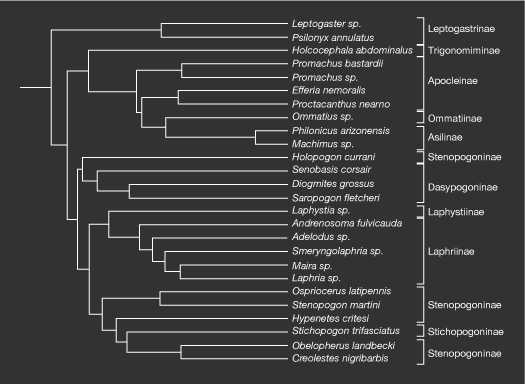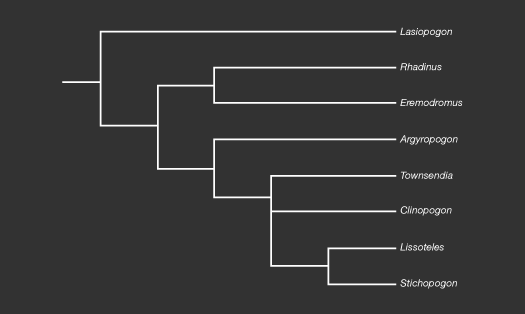Phylogenetic Relationships - recent studies
2009
A combined morphological and molecular phylogeny of Asilidae (77 species, 211 morphological characters, and approximately 7300 bp of nuclear DNA) has recently been published by Dikow (2009b). Details.
An extensive morphological phylogeny of Asilidae (158 species and 220 characters of imagines) has recently been published by Dikow (2009a). Deatils.
2004
The first molecular hypothesis of the higher-level phylogenetic relationships within the Asilidae based on DNA-sequence data was published by Bybee et al. in 2004 (A phylogeny of robber flies (Diptera: Asilidae) at the subfamilial level: molecular evidence. Molecular Phylogenetics & Evolution 30: 787–797).
The analysis is based on the 16S (mitochondrial), 18S, and 28S (both nuclear) ribosomal genes and the protein coding gene Cytochrome Oxidase II (mitochondrial), sequenced from 26 representative species of 10 of the then 11 recognised subfamily taxa.
The results were preliminary, but provided the first molecular estimate of higher-level relationships.
Main conclusions of this analysis:

© Bybee, S.M. et al. 2004. A phylogeny of robber flies (Diptera: Asilidae) at the subfamilial level: molecular evidence. Molecular Phylogenetics & Evolution 30: 789–797. Redrawn and simplified from Fig 4. Maximum likelihood topology for Asilidae of combined analysis of 16S rDNA, 18S rDNA, 28S rDNA, and COII genes.
2002
Cannings (2002) published a large revision of Lasiopogon and included a phylogenetic analysis of 8 genera of Stichopogoninae (not included were Afghanopogon and Stackelberginia). The phylogenetic hypothesis (see figure below) is based on 19 morphological characters from the complex male terminalia.
Main conclusions of this analysis:

© Cannings, R.A. 2002. The Systematics of Lasiopogon (Diptera: Asilidae). Royal British Columbia Museum, Victoria. 354 pp. Fig. 244.
